Via Appia Antica and Catacombs
Via Appia Antica
 (312 BC). Named after its builder, the Consul Appius Claudius Caecus. This direct route south to Naples and the "Boot of Italy" eventually reached Brindisi, 330 miles to the South-East.
(312 BC). Named after its builder, the Consul Appius Claudius Caecus. This direct route south to Naples and the "Boot of Italy" eventually reached Brindisi, 330 miles to the South-East.
From that port on the Adriatic, Rome's legions, after a two-week march from the capital, sailed off to conquer the eastern part of the Empire. Ancient Roman generals were great engineers.
Their fabulous consular roads radiated out from the "Urbs" like the spokes of a wheel - hence "all roads lead to Rome". The roads had to be wide enough for five Roman soldiers to march abreast, or two carriages to pass each other.
Via Appia "Regina viarum" (Queen of Roads) was surprisingly straight, and superbly surfaced with massive blocks of volcanic stone. You can still find patches of these paving blocks that were originally flat, but now have grooves worn into them by carriage wheels.
Near the GRA ("Grande raccordo", the belt parkway that circles Rome) you feel you have stepped back 2000 years, though the ancient tombs, that grew like mushrooms on either side of the road, have fallen on hard times.
Most of the Appian Way is a pedestrian park on weekends, with police keeping out (most) unauthorized vehicles.
Museum of the Walls of Rome
Just inside the Porta San Sebastiano is this largely neglected museum where you can march along the Aurelian Walls, just the way the Imperial legionnaires did when on guard duty.
In the museum models and pictures illustrate the millennial history of these beautiful walls and gates.
The Porta San Sebastiano (named after the basilica and catacombs that were frequently the destination of pilgrims passing through) is an early medieval fortress four stories high, with battlements on the twin towers and a portcullis in the center that could be lowered to protect Rome against invaders.
Just inside the gate is the early 3C monumental "Arch of Drusus" which was part of an aqueduct built by Emperor Caracalla for his eponymous Baths.
| Aurelian Walls and the defenses of Rome History 408. Alaric the Goth marched his army to the Walls of Rome and began a tight blockade. Soon the Senate sent out ambassadors, hoping to terrify him with threats of what military routs he should expect from Rome's invincible armies. Alaric gave his famous reply "The thicker the hay, the more easily mowed," and demanded a ruinous ransom of gold, silver, silk and 3000 pounds of pepper. When the envoys asked what would be left for themselves, and their fellow Romans, Alaric answered smoothly "Your lives!" Rome paid. 409. Alaric again blockaded Rome and again the Senate compromised. 410. Arriving unexpectedly, Alaric and his Goths burst through the Walls at the Salarian Gate and occupied Rome with minimum damage. This was the first Sack of Rome since 390 BC when it had fallen to a surprise attack by the Celts of Gaul. That was at the end of Rome's beginning, but this was the beginning of Rome's end. 411. Emperor Honorius built this fortified gate replacing the old Porta Appia. 6C. General Belisarius strengthened it, adding towers for protection against attack. |
Porta di S. Sebastiano (Beyond Map Area)
Domine Quo Vadis Church
 Built in 1637, on the site where Jesus Christ appeared to St. Peter who was running away from Emperor Nero's persecution of Christians in Rome. Peter, amazed by this miraculous vision asked "Domine, Quo Vadis?" (Lord, wither goest Thou?). Jesus answered "I'm going to Rome to be crucified again", and disappeared. Peter, understanding the message as a rebuke, returned to Rome and martyrdom.
Built in 1637, on the site where Jesus Christ appeared to St. Peter who was running away from Emperor Nero's persecution of Christians in Rome. Peter, amazed by this miraculous vision asked "Domine, Quo Vadis?" (Lord, wither goest Thou?). Jesus answered "I'm going to Rome to be crucified again", and disappeared. Peter, understanding the message as a rebuke, returned to Rome and martyrdom.
In the nearby Church of San Sebastiano you can see the paving stone with the supposed imprint that Christ's feet left when he shamed St. Peter.
Ardeatine Graves
Mausoleum and Museum of the Resistance on the spot where on 24 March 1944 the Nazi occupiers of Rome executed 335 civilians in reprisal for a bomb planted the previous day by the "Italian Resistance Movement" that killed 32 German soldiers.
The victims, unrelated to the bombers, included priests, officials, about 100 Jews and even a boy of 14. The Teutonic grimness of the mausoleum, with its walls like a thicket of thorns, is appropriate to the deed.
Columbarium

This is not a dovecote, but an ancient repository for urns that contained the ashes of dead slaves who had been set free by their masters.
Today it houses an attractive restaurant.
The burial hall, with its myriad niches lining the walls, is open to the skies, and provides a beautiful and cozy atmosphere for savoring traditional Italian cuisine.
The indoor tables are in the adjoining medieval building, where there is an old lithograph showing it hasn't changed much.
(Beyond Map Area)